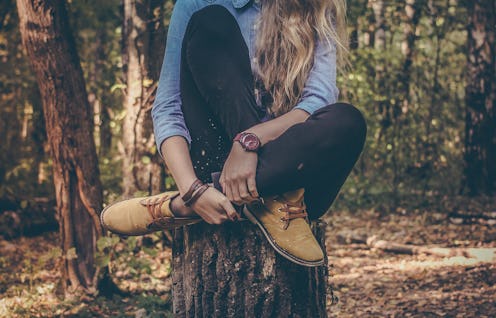
Although there are some seriously cozy images involved when we think autumn (my personal favorites are those involving furry cardigans), there are some not-so nice side effects of sweater weather, too. One case in point: Blisters from boots. Those suckers come almost on cue with the turning of the leaves, after all. While buying your new fall shoes can be a total treat, taking the time (and pain) of breaking them in is most definitely not.
Sometimes you can take all the precautions out there and still end up with painful blisters. You swaddle your feet in socks, buy expensive leather rather than cheaply worked plastic, and make sure you're not deluding yourself by buying the proper shoe size. Then your feet still get blistered by the end of the day. It's a cross to bare for the look of a bootie, but time and time again we shoulder it. There might be a way to prevent it from happening once and for all, though. There's no need to walk around in bandaged feet until you break those caramel beauties in. If you want to save yourself some pain, read on. Below are seven clever tips for how to prevent blisters in boots.
1. Take Precautions Before They Happen
If you're prone to blistering, take the extra (cautious) mile and bandage up the parts of your feet that usually get rubbed raw before you put the boots on. For example, wrap up the vulnerable areas like pinkies, big toes, your sides, and/or heels. If they have an extra barrier around them, then they'll be that much safer. But now, what kind of Band-Aid to use? If you're anything like me, you've been let down by weak little bandages that just give up and slip off of your feet one too many times.
According to beauty writer Alle Connell of xoVain, "Not all Band-Aids are created equal, and they don’t all work on feet, which move a lot and get sweaty. The best Band-Aids for feet are the Band-Aid brand Tough Strips. Not the waterproof ones — just the regular fabric kind. They aren’t cute, but they work brilliantly, and they come in a bunch of useful sizes." Go with a hardcore adhesive, and your feet will be safe.
2. Sprinkle In Some Cornstarch
Blisters are created because of friction, and friction happens more often when you have wet (read: sweaty) conditions. So to soak up extra moisture and minimize foot-rubbing opportunities, sprinkle some cornstarch in your boot and a little in your sock, keeping your feet and shoes dry. My mom swears by this and she claims she doesn't even know what a blister feels like. You should trust her. She's got mom skillz.
3. Stretch Out The Boots In Question With Heat
Sometimes it's not moisture that creates the blister, but rather the boot being too tight. For moments like those, it's best to go to a shoe repair and get them professionally stretched. But if you're on a budget, you can try doing it yourself at home. All you need to do is apply heat.
Blow-dry a pair of socks for about two to three minutes until they're hot (but not scalding!) and then slip them on. Put on your new boots and walk around the house in them. The heat will expand them, and your thick socks will help add their weight into the stretching while protecting your feet. According to style writer Augusta Falletta at StyleCaster, "The heat will help to warm up the shoes and break them in a bit, and walking around with the socks will prevent your feet from getting blisters." It's a good precaution to take before you spend a full day in them!
4. Take An Unconventional Approach
Sometimes Band-Aids and cornstarch just aren't enough. For times like those, unconventional products might be the life savers you were looking for. According to Claire Coleman at The Daily Mail, nipple petals are everything (those are the silicone pasties you put over your nips when you don't want to wear a bra). Most of them are machine washable and can be reused many times over and add more cushion and protection than a simple Band-Aid or thick sock. Coleman said, "These are brilliant, especially if you’ve already got the beginnings of a blister."
5. Invest In Professional Products
If none of these DIY ways work for you, then maybe it's time to head to the pros and invest in some products. Apparently, Dr. Scholl's Blister Defense is a complete life changer and will keep those blister-prone spots dry and pain-free. According to beauty writer Alle Connell of xoVain, "IT WORKS. A little bit of this rubbed onto any area that you fear might get a blister, and you’re done. It isn’t slippery or slimy. It doesn’t smell. It just cuts down on friction. No more friction equals no more potential blister."
Race you to the drugstore, guys?
Images: szolkin/Unsplash